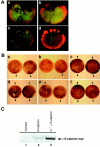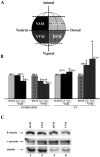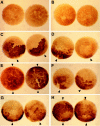Establishment of the dorso-ventral axis in Xenopus embryos is presaged by early asymmetries in beta-catenin that are modulated by the Wnt signaling pathway
- PMID: 9060476
- PMCID: PMC2132470
- DOI: 10.1083/jcb.136.5.1123
Establishment of the dorso-ventral axis in Xenopus embryos is presaged by early asymmetries in beta-catenin that are modulated by the Wnt signaling pathway
Abstract
Eggs of Xenopus laevis undergo a postfertilization cortical rotation that specifies the position of the dorso-ventral axis and activates a transplantable dorsal-determining activity in dorsal blastomeres by the 32-cell stage. There have heretofore been no reported dorso-ventral asymmetries in endogenous signaling proteins that may be involved in this dorsal-determining activity during early cleavage stages. We focused on beta-catenin as a candidate for an asymmetrically localized dorsal-determining factor since it is both necessary and sufficient for dorsal axis formation. We report that beta-catenin displays greater cytoplasmic accumulation on the future dorsal side of the Xenopus embryo by the two-cell stage. This asymmetry persists and increases through early cleavage stages, with beta-catenin accumulating in dorsal but not ventral nuclei by the 16- to 32-cell stages. We then investigated which potential signaling factors and pathways are capable of modulating the steady-state levels of endogenous beta-catenin. Steady-state levels and nuclear accumulation of beta-catenin increased in response to ectopic Xenopus Wnt-8 (Xwnt-8) and to the inhibition of glycogen synthase kinase-3, whereas neither Xwnt-5A, BVg1, nor noggin increased beta-catenin levels before the mid-blastula stage. As greater levels and nuclear accumulation of beta-catenin on the future dorsal side of the embryo correlate with the induction of specific dorsal genes, our data suggest that early asymmetries in beta-catenin presage and may specify dorso-ventral differences in gene expression and cell fate. Our data further support the hypothesis that these dorso-ventral differences in beta-catenin arise in response to the postfertilization activation of a signaling pathway that involves Xenopus glycogen synthase kinase-3.
Figures








References
-
- Behrens J, von Kries JP, Kuhl M, Bruhn L, Wedlich D, Grosschedl R, Birchmeier W. Functional interaction of β-catenin with the transcription factor LEF-1. Nature (Lond) 1996;382:638–642. - PubMed
-
- Bhanot P, Brink M, Samos CH, Hsieh J-C, Wang Y, Macke JP, Andrew D, Nathans J, Nusse R. A new member of the frizzled family from Drosophilafunctions as a Wingless receptor. Nature (Lond) 1996;382:225–230. - PubMed
-
- Brannon M, Kimelman D. Activation of Siamoisby the Wnt pathway. Dev Biol. 1996;180:344–347. - PubMed
-
- Cardellini P. Reversal of dorsal ventral polarity in Xenopus laevisembryos by 180° rotation of the animal micromeres at the eight cell stage. Dev Biol. 1988;128:428–434. - PubMed
-
- Carnac G, Kodjabachian L, Gurdon JB, Lemaire P. The homeobox gene Siamoisis a target of the Wnt dorsalization pathway and triggers organizer activity in the absence of mesoderm. Development (Camb) 1996;122:2055–3065. - PubMed
Publication types
MeSH terms
Substances
Grants and funding
LinkOut - more resources
Full Text Sources
Research Materials

